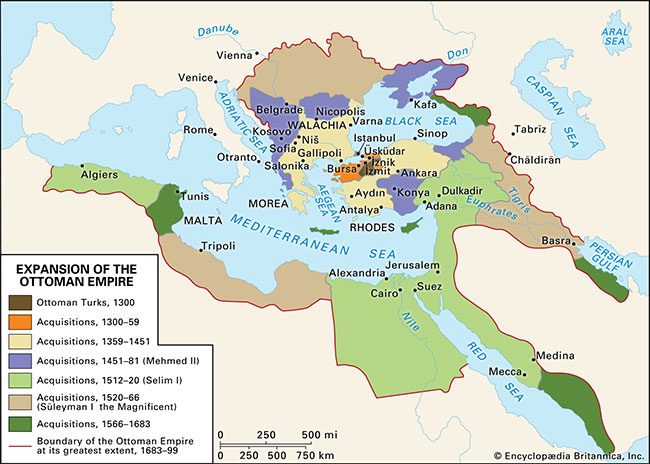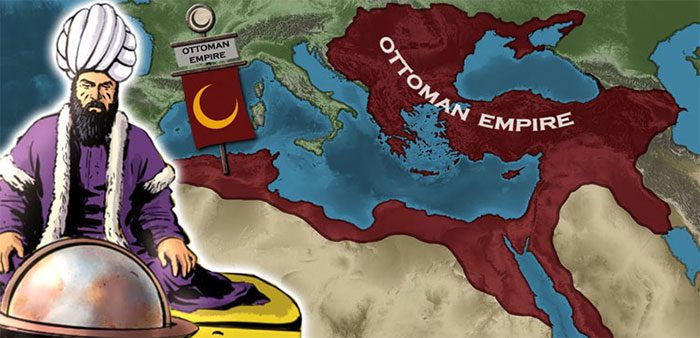The Ottoman Empire was one of the greatest and most powerful empires in human history. Existing for over 600 years, from the late 13th century (1299) to the 20th century (1923), the territory of the Ottoman Empire spanned an area of 5.6 million square kilometers.
The 624-year journey of the Ottoman Empire, from its inception and powerful development to its gradual decline, is documented by history, and National Geographic invites readers to explore this topic.

At its peak, the territory of the Ottoman Empire included regions in Anatolia, the Middle East, much of North Africa…
The Ottoman Empire (also known as the Turkish Empire) developed from a Turkish stronghold in the Anatolian peninsula into a vast nation. At its height, the territory of the Ottoman Empire included regions in Anatolia, the Middle East, significant parts of North Africa, and much of Southeastern Europe extending to the Caucasus. To the north, it reached as far as Vienna, Austria; to the east, it bordered the Persian Gulf; to the west, it included Algeria; and to the south, it extended to Yemen.
The success of the Ottoman Empire lay in the centralized management system of its leaders. Control over some of the world’s most lucrative trade routes allowed the empire to quickly amass wealth. Meanwhile, a well-organized military system enabled the Ottomans to maintain one of the strongest armies in history.
However, the Ottoman Empire was not exempt from the law of rise and fall. For over six centuries, the Ottoman Empire rose powerfully from Anatolia, only to eventually collapse tragically in the context of World War I.
The Empire’s Powerful Rise
The Ottoman Empire was first established in the northwestern part of present-day Anatolia (Asia Minor) by Osman I, a leader of a nomadic Turkish tribe, in the late 1200s.
By the end of the 13th century, Osman I began conquering the Anatolian region by launching attacks against the weakened Byzantine Empire.
Around 1299, he declared himself the supreme leader of Asia Minor, and his successors expanded further into the territory of the Byzantine Empire with the help of mercenary forces from outside.
By the mid-14th century, the Ottomans had advanced westward and taken control of the Balkans. Just 100 years later, the Ottoman Empire helped overthrow the Roman Empire, and by the 17th century, it had expanded into areas of Western Asia, Southeastern and Central Europe, Northern and Northeastern Africa, and the Caucasus.
At this point, the Ottoman Empire covered 5.1 million square kilometers and controlled a population of about 15 million people. The Ottoman Empire became one of the largest and most powerful empires in human history.
In 1453, the descendants of Osman, known as the Ottomans, ultimately forced the Byzantine Empire to capitulate when they conquered the “unconquerable city” of Constantinople. The city, named after Constantine, the first Christian emperor of Rome, later became known as Istanbul.
The Ottoman Empire ushered in a new dynasty, with its capital in Istanbul, and continued to expand its territory throughout the Balkans, the Middle East, and North Africa.
Under the reign of Suleiman I (also known as Suleiman the Lawgiver) – the 10th and longest-reigning Sultan of the Ottoman Empire – the Ottomans entered their most prosperous period in history from the 16th century onward.
World history recognizes Suleiman I (1494-1566) as the most famous monarch in 16th-century Europe. With his achievements in restructuring the Ottoman legal system, he brought the empire to the pinnacle of military, political, and economic glory.
Furthermore, under his reign, Ottoman art and architecture flourished, reaching new heights.
Of course, no empire that dominated such a vast region throughout history could be without its dark corners. Political infighting and power struggles among the royal family of the Sultans persisted. There were still slaves forced to labor and serve in the military for the state. Nevertheless, the people of the empire generally enjoyed peace, religious freedom, and economic and political stability.
The Decline of the Ottoman Empire
At its peak, the Ottoman Empire was a formidable force on the political map of Europe and had more Christians than Muslims. However, entering the 17th century, the Ottoman Empire began to lose its stronghold.

By the 19th century, the Ottoman Empire was truly weakening as its territory shrank.
Despite continuing military campaigns for new territories, the empire began to weaken after failing to conquer Vienna for the second time in 1683.
Political intrigues during the reign of the Sultan; the European powers taking turns consolidating their authority; fierce economic competition for new trade routes; and the onset of the Industrial Revolution all contributed to the instability of the once unparalleled empire.
By the 19th century, the Ottoman Empire was genuinely in decline, with shrinking territory, a declining economy, and an increasing dependency on the rest of Europe.
The Balkan Wars in 1912 and 1913 caused significant territorial and population losses for the Ottoman Empire. Specifically, the Ottoman Empire lost 33% of its territory and 20% of its population after conflicts in the Balkan Peninsula in Southeastern Europe.
By the mid-19th century, the Ottoman Empire undertook reforms aimed at modernizing the country, attempting to regain some of its lost strength. However, these efforts largely failed, and during World War I, the empire completely collapsed.
When World War I (1914-1918) broke out, the Ottoman Empire joined a secret alliance with Germany. The ensuing conflict was disastrous, as the collapse of the Ottoman Empire was a direct consequence of World War I. More than two-thirds of the Ottoman military perished in World War I, and up to 3 million civilians lost their lives.
Among them were approximately 1.5 million Armenians who were exterminated during the massacres and death marches as they were expelled from Ottoman territory.
The Central Powers (the German Empire, the Austro-Hungarian Empire…) that the Ottoman Empire allied with were ultimately defeated. As a result, the Ottoman Empire was conquered and divided by the British, Greeks, French, Italians, and others.
In 1922, Turkish nationalists abolished the monarchy, bringing an end to what had once been the pinnacle of one of the most successful and powerful empires in history.
In total, the Ottoman Empire experienced 36 reigns from 1299 to 1922. After more than 600 years of existence, the Ottoman Empire is still remembered today for its powerful military, ethnic diversity, exquisite art, and magnificent architectural works. The influence of this empire remains strong in modern-day Turkey.


















































